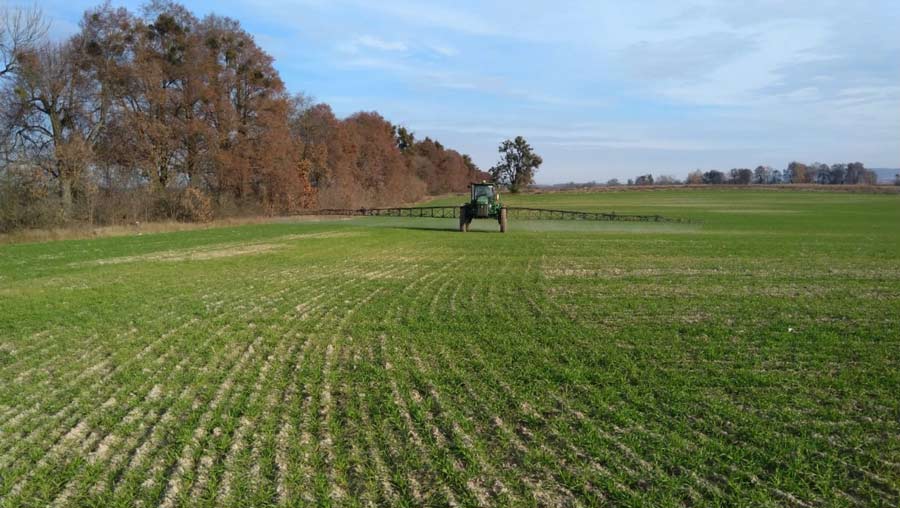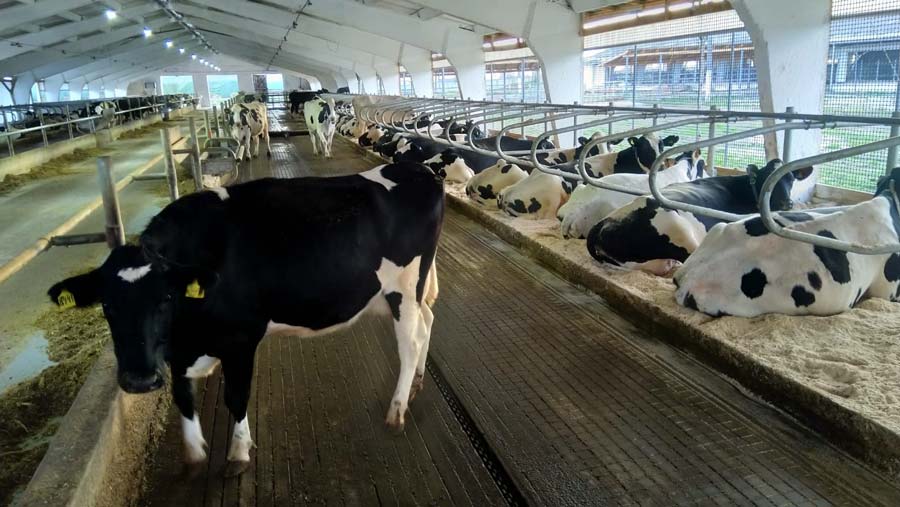Ukraine’s farmers winning battle to feed world, says analyst
 © Victor Boltruchnuk
© Victor Boltruchnuk Ukrainian farmers are defying the odds and winning the battle to grow crops and feed the world, says a Black Sea independent analyst.
Mike Lee, director of Green Square Agro Consulting, says Ukrainian farmers have done an “unbelievable job” in the face of Russian aggression and missiles raining down across their country.
Farmers have faced problems sourcing labour, diesel, fertiliser and other crop inputs.
See also: Farmers Weekly Awards 2022: Farming Champion of the Year
“Back in the spring, there was a lot of doom-mongering that Ukrainian farmers would not be able to farm, but with full respect, they have done incredibly well,” said Mr Lee.
“In February and March, people asked if Ukraine could grow and harvest anything.”
Earlier this year, concerns were raised about a possible shortage of wheat on the world market because of the barrier to exports from Black Sea ports and fears that insufficient wheat would be harvested.
Ukrainian farmers harvested about 19m tonnes of wheat from 4.7m hectares this year, averaging 4.12t/ha.
Last year, Ukraine produced a record wheat harvest of 33m hectares but from 7.4m hectares.
Unaccounted wheat
This year, about two million hectares of wheat were unaccounted for because it had been destroyed, was too dangerous to harvest, or was in Russian-occupied territories.
It’s unclear how much wheat was produced in the occupied territories or where it has gone, said Mr Lee.
“Because farmers are struggling to sell the current crop and prices are low, there was talk that Ukraine’s wheat hectares would be down significantly this autumn.
“But on a pro-rata basis, plantings look likely to finish up only around 10% down on last year.
“On land they have access to, Ukrainian farmers are planting wheat hectares at levels broadly similar to previous years, but there is a lot of land in the occupied territories that we don’t know what is happening there. It’s possible wheat is being planted there, but we don’t know yet.”
The current wheat price is around $300/t, (£265/t) but where Ukrainian farmers can get a quote, they are being offered much less – in some cases $100/t (£88/t), as traders factor in risk and higher costs, Mr Lee said.
Although the prices are not good for Ukrainian farmers, they have to sell where they can to help cashflow.
Meanwhile, farmers in the neighbouring countries of Moldova and Romania struggle to sell their wheat, as traders look across the border for more lucrative deals in Ukraine.
Last month, the farmers of Ukraine were collectively named Farmers Weekly Farming Champion of the Year for their courage and defiance to carry on farming in fear of their lives and those of their families amid Russian aggression.
2022 harvest and field work progress in Ukraine
Ukraine’s ministry of agrarian policy reported that, as of 1 November, farmers had planted 3.5m hectares of winter wheat – or 87% of the projected area.
This leaves farmers on course to plant 4m hectares of winter wheat in Ukrainian-controlled territories.
With spring wheat planted next April, Ukraine’s total wheat area in Ukraine-controlled territories for 2023 looks to be around 4.2m hectares.
This would be down 10% from what was harvested last year and could produce a crop of about 17m tonnes.
It’s unclear what planting is taking place in the occupied territories, but it could be as much as an additional 1.6m hectares, producing a potential 6m tonnes, bringing Ukraine’s possible 2023 total wheat harvest to 23m tonnes.
As of 4 November, the 2022 wheat, barley and OSR harvests were completed.
Ukraine recorded a wheat harvest of 19.4m tonnes from 4.7m hectares, a barley harvest of 5.6m tonnes from 1.6m hectares (down from 10.2m tonnes in 2021), and an OSR harvest of 3.2m tonnes from 1.1m hectares (up from 3m tonnes in 2021).
Ukraine’s maize harvest is 27% complete, with a forecast of 4.1m hectares, and likely to produce around 28m tonnes. Sunflower harvest is 87% complete and looks set to produce around 11m tonnes.
Soya beans were also on the home straight (85% of harvest completed) and look likely to finish around 3.5m tonnes.
Russia update
Meanwhile, the ministry of agriculture of the Russian Federation reported that Russia expects to record a grain harvest of 150m tonnes for 2022, including a historic wheat harvest of 100m tonnes.
But Mr Lee remains sceptical about this figure, given that Russia’s previous record wheat harvest was 86m tonnes. He believes Russia’s extra yield includes wheat from conflict zones in Ukraine.
The US Department of Agriculture (USDA) is also not convinced of a record Russian wheat crop, saying that remote sensing indicators throughout the growing season highlight above-average conditions but not record yields.
The USDA estimated Russia’s wheat crop at 91m tonnes.
Mr Lee said Russia continues to export grain to new and existing countries they have dealt with in the past, and current wheat exports are within 5% compared with last year.
However, Russia is complaining that “hidden sanctions” by the EU and the US are hindering transactions for grain and fertiliser.
EU and US sanctions are not applied to food and fertiliser, but sanctions on banking, finance and insurance indirectly affect Russia’s ability to export grain and fertiliser.
Grain deal
Mr Lee said the Turkish-brokered United Nations agreement that guarantees a safe passage for ships carrying vital grain exports through a Black Sea corridor, and export routes for train wagons of agricultural produce transported over western borders, had provided a lifeline to Ukrainian farmers.
The Black Sea grain deal is due to expire on 19 November, and Mr Lee expects a lot of discussion over the next fortnight over whether Russia will re-sign.
“My instinct is that Russia will agree to extend the deal at the 11th hour. Whatever happens, it will impact the wheat price in the UK,” he noted.
Case study: Victor Boltruchnuk, dairy farm worker, western Ukraine

Renovated barn housing dairy cows in western Ukraine © Victor Boltruchnuk
Defiant Ukrainian farmers are united in their push to continue to grow crops and feed the world, insists dairy farm worker Victor Boltruchnuk.
Mr Boltruchnuk said Ukrainian farmers continue to persevere in very difficult circumstances while their country is under illegal occupation from Russian troops.
“I think farmers in every country are among the most resilient and bravest of people. They are confronted with uncertainty of all different risks – the weather, prices, the future and everything else,” he added.
“We are used to working long hours in difficult conditions, which is why many infantries rely on farmers to help out on the frontline.”
Mr Boltruchnuk, who farms in the west of Ukraine, near the Polish border, said his own company was pressing ahead with upgrades to dairy buildings despite the war.
The biggest challenges farmers face remain access to fuel, fertiliser, inputs, labour and machinery, he added.
Mr Boltruchnuk said Ukrainian farmers who are farming near the frontline are risking their lives daily to grow crops and rear livestock.
“In regions close to the combat zones, tractor drivers are wearing helmets and plate carriers. They risk driving over mines and they sometimes suffer from direct air raids as planes and helicopters just attack machinery in the fields,” he added.
“They are at direct risk every day and there are lots of videos in Ukraine where farmers have just evaded aircraft strikes.”
In some regions, Mr Boltruchnuk said Russian troops are stealing machinery and grain, torching crops and shelling livestock on pastures with their bombs.
In some cases, the Russians had taken over Ukrainian farms and were forcing workers to work for nothing, he added.
Finally, he described the 2022 harvest as “mixed” and said autumn drilling in some regions was hampered by a wet September, but crops that were planted have now emerged and look good.
